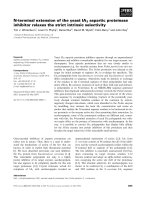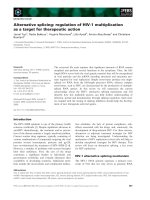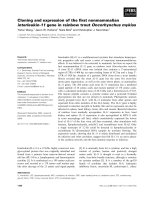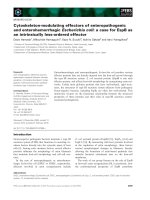báo cáo khoa học: "Malignant fibrous histiocytoma of the urinary bladder as a post-radiation secondary cancer: a case report" pdf
Bạn đang xem bản rút gọn của tài liệu. Xem và tải ngay bản đầy đủ của tài liệu tại đây (11.15 MB, 6 trang )
CAS E REP O R T Open Access
Malignant fibrous histiocytoma of the urinary
bladder as a post-radiation secondary cancer: a
case report
Thirayost Nimmanon
1*
and Poonkiat Ruengpoka
2
Abstract
Introduction: Malignant fibrous histiocytomas have been periodically reported as the primary tumor in various
organs including the urinary bladder, and is the second most frequent sarcoma of the urinary tract in adults. This
report discusses a case of the well established diagnosis of a malignant fibrous histiocytoma of the bladder
occurring as a post-radiation cancer after the treatment of a cervical carcinoma. Our findings support those of
many previous studies and make the view of the nature of the disease clearer.
Case presentation: We report the case of a 54-year-old Thai woman who had been treated with radiation therapy
for cervical cancer, who presented to our facility with urinary incontinence. Initially, our patient was diagnosed as
having a high-grade urothelial carcinoma. Subsequent radical surgery rendered the final pathological diagnosis,
confirmed histologically and immunohistochemically as malignant fibrous histiocytoma, with clinical and
pathological staging of T4b N0 M0. Adjuvant chemotherapy was provided for our patient.
Conclusions: This type of malignancy is very aggressive and easily misdiagnosed due to its rarity. Therefore, in a
patient with a prior history of irradiation in the pelvic area, this should be considered as a differential diagnosis to
ensure early correct diagnosis and treatment.
Introduction
While commonly found as a soft tissue tumo r and con-
sidered as the most common soft tissue sarcoma in
adults over the age of 40 years [1], malignant fibrous
histiocytomas, or the recentl y named undifferentiated
high-grade pleomorphic sarcomas, are periodically
reported as the primary tumor in various organs, includ-
ing the urinar y bladder [2]. Even though it is considered
rare in the urinary tract, it is counted as the second
most frequent sarcoma of the urinary tract in adults [3] .
Information about this tumor is still limited due to its
rarity, and several tumors previously reported as malig-
nant fibrous histiocytomas were in fact sarcomatoid
urothelial carcinomas. We report a case of malignant
fibrous histiocytoma originating from the urinary blad-
der, presenting as a post-radiation bladder cancer.
Case presentation
A 54-year old Thai woman presented to our facility with
a two-month history of urinary incontinence induced by
coughing.
She had a history of cervical squamous cell carcinoma,
stage IIb, which was t reated 15 years previously with
radiation therapy. Her six-month interval follow-up pel-
vic examination and cervicovaginal PAP smears had
revealed negative findings and the disease had been con-
sidered as in complete remission by the attending radi-
ologist. She was first referred to our gynecology
department to find out the cause of her incontinence.
On pelvic examination by a gynecol ogist, her uterine
cervix was found to be atrophic with an extraluminal
compression at the anterior vaginal wall, covered by an
intact vaginal mucosa. Laboratory investigation results
revealed mild hematuria (3 to 5 red blood cells per
high-power field) and mild anemia (hemoglobin 10 g/
dL, hematocrit 31.1%). Eventually, our patient was
referred to our urology department for further
management.
* Correspondence:
1
Department of Pathology, Phramongkutklao College of Medicine, 315
Ratchawithi Road, Thung Phayathai, Ratchathewi, Bangkok 10400, Thailand
Full list of author information is available at the end of the article
Nimmanon and Ruengpoka Journal of Medical Case Reports 2011, 5:549
/>JOURNAL OF MEDICAL
CASE REPORTS
© 2011 Nimmanon and Ruengpoka; licensee BioMed Central Ltd. This is an Open Access article distributed under the terms of the
Creative Commons Attribution License ( which permits unrestricted use, distribution, and
reproduction in any medium, pro vided the original work is properly cited.
During the process of the Q-tip test, the applicator
was passed with difficulty and deviation to the right.
Cystoscopy was performed. Her urethra showed no
meatal stenosis and unremarkable mucosa, but the
device was passed with difficultly due to external c om-
pression from the left side of the proximal urethra. Her
bladder had a large sessile mass on the left lateral wall
with extension to the bladder neck. Both ureteral ori-
fices could be identified clearly with unremarkable
appearance and efflux. Clinically, the differential diagno-
sis included recurren t cervical cancer, bladder cancer
and retroperitonal sarcoma. Urine cytology and transur-
ethral resection of the bladder tumor were performed,
withanegativecytologyreportandapathologicaldiag-
nosis of high-grade urothelial carcinoma. A computed
tomography scan demonstrated a heterogenous enhan-
cing mass, 5.3 × 6.5 × 6.0 cm, at the left infe rior-lateral
wall of the bladder with invasion of the uterus and
attachment to the left pelvic side wall, as shown in Fig-
ures 1 and 2. There was no hydronephrosis, hydroureter,
liver mass or lymphadenopathy seen radiologically . Sub-
sequently, anterior pelvic exenteration and ileal conduit
with pelvic lymphadenectomy, as well as an incidental
appendectomy, were performed.
Gross pathological examination revealed a large mass
on the left lateral wall that measured 7.0 cm across its
greatest dimension. The surface of the tumor on the
mucosal side was smooth. The mass obviously pro-
truded from the serosal surface of the bladder and was
attached to the uterus, but could still be separated from
the organ with ease.
Microscopically, the overlying urothelium was intact
with no dysplastic change (Figure 3). The underlying
mass was composed of highly pleomorphic spindle-to-
polygonal shaped neoplastic cells with frequent mitotic
figures and many atypical ones (Figures 4 and 5). Their
cytoplasms ranged from clear to pale on eosinophilic
staining. Many cells contained bizarre-shaped nuclei with
focal multinucleated giant cells. No definite component
of urothelial carcinoma was seen. An immunohistochem-
ical study was performed, showing that the neoplasm was
immunoreactive for vimentin (Figure 6) and CD68 (Fig-
ure 7), but negative for epithel ial marke r (AE1/AE3) and
other markers for soft tissue tumors (desmin, smooth
muscle actin and S-100 protein). A CD10 test was also
performed for exclusion of carcinoma of renal cell origin,
and yielded a nega tive result. Therefore, a diagnosis of
malignant fibrous histiocytoma was made.
Pathologi cal findings from other organs, including the
uterine cervix, were unremarkable. No residual cervical
dysplasia or neoplasm was detected. All 12 lymph nodes
showed no neoplasm. The disease was clinically and
pathologically staged as T4b N0 M0.
After surgery, our radiation t herapist advised not
providing additional r adiation therapy in the pelvic
area. Our patient, therefore, r eceived a course of adju-
vant chemo therapy (doxorubicin and ifosfamide). How-
ever, two months after the surgery, a bony metastasis
Figure 1 Computed tomography of the pelvic cavity at the levels of the neoplasm.
Nimmanon and Ruengpoka Journal of Medical Case Reports 2011, 5:549
/>Page 2 of 6
was detected at the L5 spine level, and palliative radia-
tion therapy in that area was suggested. Despite
aggressive surgical treatment along with adjuvant che-
motherapy and palliative radiation therapy, our patient
developed further locally recurrent disease with inva-
sion to the right pubic bone and rectum. At this time,
a multidisciplinary approach for palliation of our
patient’s symptoms is still in process.
Figure 2 Computed tomography of the pelvic cavity at the levels of the neoplasm.
Figure 3 The intact urothelial lining with underlying malignant neoplasm (low magnification).
Nimmanon and Ruengpoka Journal of Medical Case Reports 2011, 5:549
/>Page 3 of 6
Discussion
Our patient had received a full course of radiation ther-
apy in her pelvic area and, hypothetically, the bladder
sarcoma developed from radiation-induced genetic
alterations. The mass developed rapidly and behaved
aggressively.
From her clinical history, for purposes of retrospective
study, our patient’ s presentation was not typical for a
Figure 4 Highly pleomorphic neoplastic cells with clear to pale eosinophilic cytoplasm (higher magnification).
Figure 5 Some cells contained bizarre-shaped nuclei and some showed atypical mitotic figures.
Nimmanon and Ruengpoka Journal of Medical Case Reports 2011, 5:549
/>Page 4 of 6
conventional urothelial carcinoma, as the mass was large
while producing negative urine analysis and negative
urine cytology results. Even though squamous cell carci-
noma of the bladder is strongly associated with chronic
irritation or inflammation, it is still unlikely due to the
laboratory results and no strong association with radia-
tion has been reported. The history of radiation expo-
sure produced a suspicion of mesenchymal tumor
Figure 6 Immunohistochemical study results showing that the neoplasm was immunoreactive for vimentin.
Figure 7 Immunohistochemical study results showing that the neoplasm was immunoreactive for CD68.
Nimmanon and Ruengpoka Journal of Medical Case Reports 2011, 5:549
/>Page 5 of 6
origin. The reported incidence of post-irradiation sar-
coma range s from some few per thousand to nearly 1%
[4]. However, most cases have been seen in patients
with breast cancer who received adjuvant radiation ther-
apy, and the sites of sarcomas are usually soft tissue in
origin. Even though her history indicated that the biopsy
diagnosis was high-grade urothelial carcinoma, the diag-
nosis was reasonable, in our opinion, because of the
much higher incidence of urothelial carcinomas, fre-
quently found sarcomatoid components in high-grade
urothelial carcinomas, and limited clinical information
available. From gross pathological examination, the mass
was obviously u nlikely for carcinomas, as tumors at this
large size u sually present a s a bulky mass, often with
necrosis, and should not have a smooth surface. There-
fore, suspicion of sarcomas or lymphomas should be
raised.
Few cases of malignant fibrous histiocytoma of the
urinary bladder have been reported so far [2]. After a
complete international medical literature search, one lit-
erature review showed that there had been 29 cases
reported up to 2010, and the tumors appear mostly in
men (4:1) with a mean age of 60 years (20 to 84), and
usually m anifest as macroscopic hematuria or irritative
urinarysymptoms[5].Asinourpatient’ s case, some
authors have found an association between malignant
fibrous histiocytoma and radiation therapy [6].
Many authors have reported that this type of malig-
nancyisveryaggressive,withahighlocalrecurrence
rate and a requirement for aggressive treatment with a
combination of radical surgery and systemic chemother-
apy [5,7,8], while some authors have questioned whether
radical oncosurgery is justified for the treatment of pri-
mary malignant fibrous histiocytoma of the urinary
bladder or not due to its dismal outcome in spite of the
early stage of diagnosis [9].
Conclusions
In summary, malignant fibrous histio cytoma is consi d-
ered as a rare malignancy of the urinary bladder. How-
ever, some of the previously diagnosed high-grade
carcinomas might actually be this type of sarcoma. We
suspect that the radiation exposure might be a contri-
buting factor to this rare mesenchymal neoplasm. Cor-
rect diagnosis requires immunohistochemical studies
with a large panel of antibodies in close correlation with
histological and cytological features [10].
Consent
Written informed consent was obtained from the patient
for publicatio n of this case report and any accompany-
ing images. A copy of the written consent is available
for review by the Editor-in-Chief of this journal.
Acknowledgements
We would like to express our gratitude to Ronnarit Singpru, who provided
data on our patient to the authors.
Author details
1
Department of Pathology, Phramongkutklao College of Medicine, 315
Ratchawithi Road, Thung Phayathai, Ratchathewi, Bangkok 10400, Thailand.
2
Division of Urology, Department of Surgery, Phramongkutklao Hospital, 315
Ratchawithi Road, Thung Phayathai, Ratchathewi, Bangkok 10400, Thailand.
Authors’ contributions
PR analyzed and interpreted the data from our patient regarding the
neoplasm, and performed the operation. TN performed the histological
examination and interpretation of immunohistochemical study results, and
was a major contributor to writing the manuscript. All authors read and
approved the final manuscript.
Competing interests
The authors declare that they have no competing interests.
Received: 12 July 2011 Accepted: 10 November 2011
Published: 10 November 2011
References
1. Gustafson PL: Soft tissue sarcoma: epidemiology and prognosis in 508
patients. Acta Orthop Scand Suppl 1994, 259:1-31.
2. De Padua M, Subramanium N: Benign fibrous histiocytoma of the
bladder. Indian J Urol 2007, 23:72-74.
3. Cheville J: Malignant fibrous histiocytoma. In Pathology and Genetics of
Tumours of the Urinary System and Male Genital Organs. Edited by: Eble JN,
Sauter G, Epstein JI, Sesterhenn IA. Lyon, France: IARC Press; 2004:143.
4. Karlsson P, Holmberg E, Samuelsson A, Johansson KA, Wallgren A: Soft
tissue sarcoma after treatment for breast cancer - a Swedish population-
based study. Eur J Cancer 1998, 34:2068-2075.
5. Povo-Martín I, Gallego-Vilar D, Bosquet-Sanz M, Miralles-Aguado J, Gimeno-
Argente V, Rodrigo-Aliaga M, Gallego-Gómez J: Malignant fibrous
histiocytoma of the bladder: a literature review [in Spanish]. ACTA Urol
Esp 2010, 34:378-385.
6. Barriol D, Lechevallier E, Ortega JC, Koutani A, Dussol B, de Fromont M,
Coulange C: Malignant histiocytofibroma of the bladder: a case report
[in French]. Prog Urol 1997, 7:270-272.
7. Anglada Curado FJ, López Beltrán A, Prieto Castro R, Regueiro López JC,
Leva Vallejo M, Alameda Aragoneses V, Blanco Espinosa A, Moreno Arcas P,
Requena Tapia MJ: Malignant fibrohistiocytoma of the bladder [in
Spanish]. Actas Urol Esp 2000, 24:581-583.
8. Froehner M, Manseck A, Haase M, Hakenberg OW, Wirth MP: Locally
recurrent malignant fibrous histiocytoma: a rare and aggressive
genitourinary malignancy. Urol Int 1999, 62:164-170.
9. Gunia S, May M, Koch S, Erbersdobler A: Is radical oncosurgery justified for
the treatment of primary malignant fibrous histiocytoma of the urinary
bladder? Report of two cases and analyses of disease-specific survival
rates based on a review of the literature. Urol Int 2011, 86:261-268.
10. Kunze E, Theuring F, Krüger G: Primary mesenchymal tumors of the
urinary bladder. A histological and immunohistochemical study of 30
cases. Pathol Res Pract 1994, 190:311-332.
doi:10.1186/1752-1947-5-549
Cite this article as: Nimmanon and Ruengpoka: Malignant fibrous
histiocytoma of the urinary bladder as a post-radiation secondary
cancer: a case report. Journal of Medical Case Reports 2011 5:549.
Nimmanon and Ruengpoka Journal of Medical Case Reports 2011, 5:549
/>Page 6 of 6









